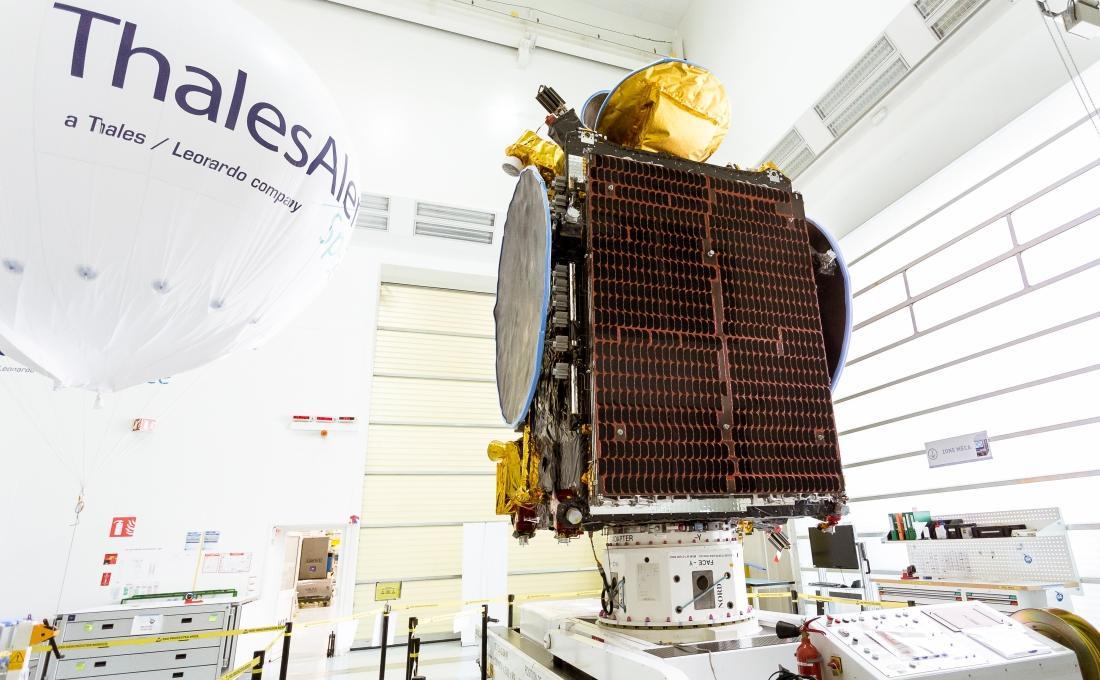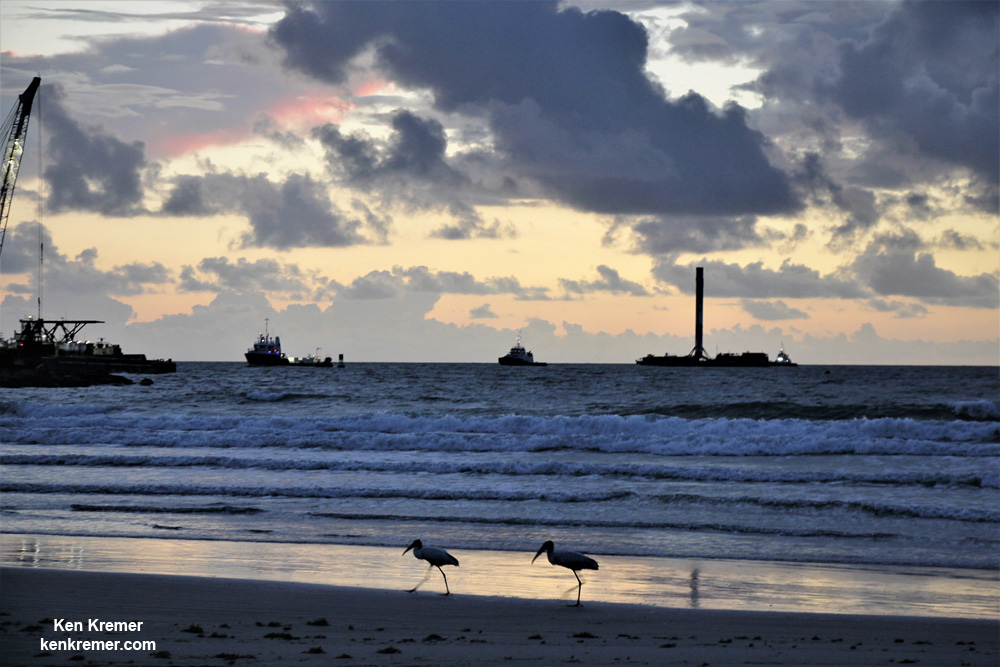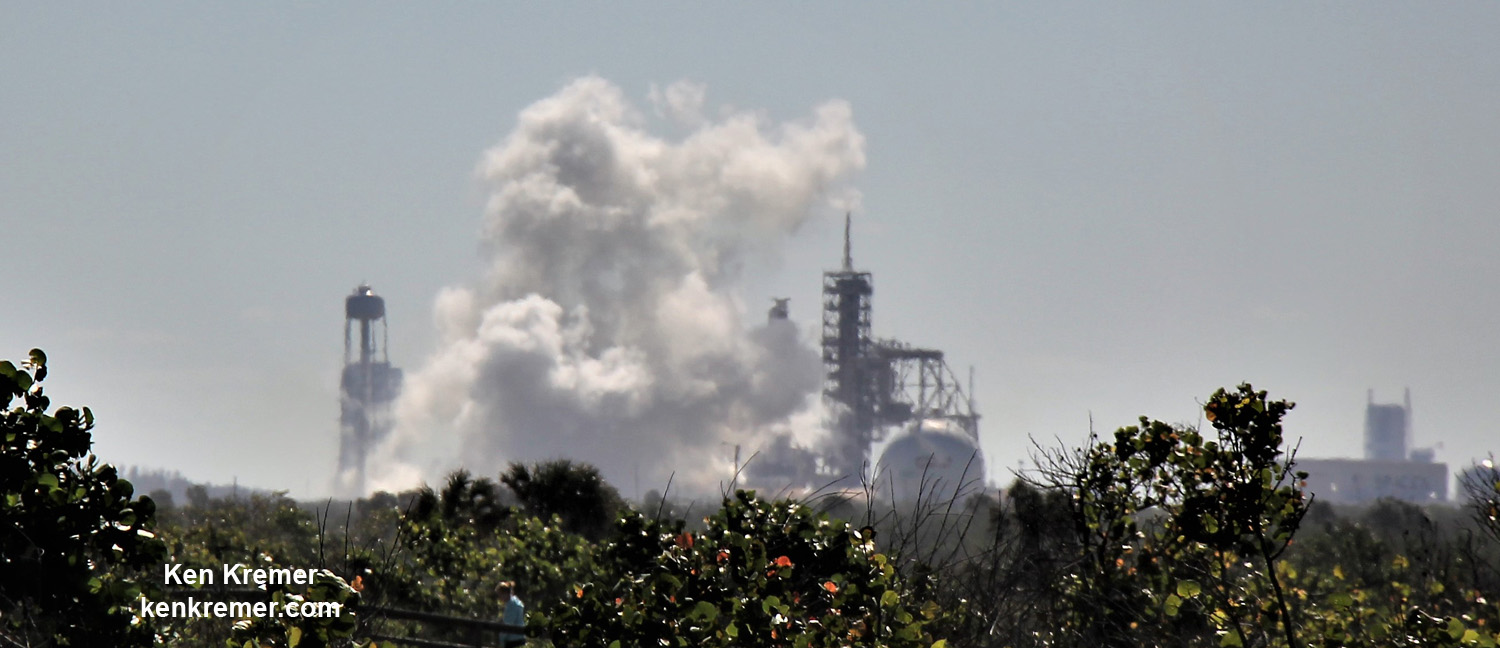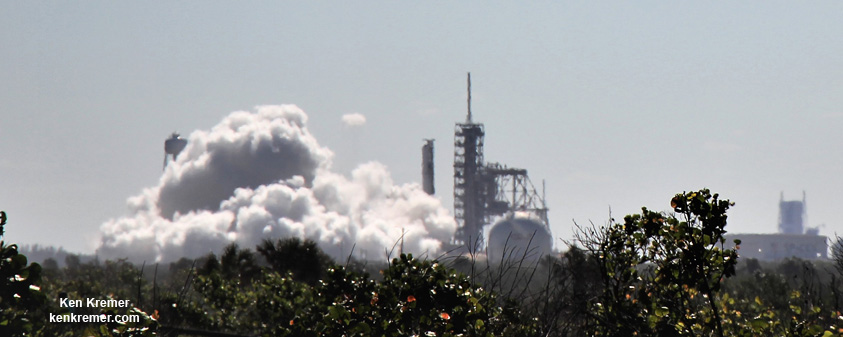
SpaceX Falcon 9 recycled rocket carrying SES-11/EchoStar 105 UHD TV commercial comsat raised erect atop Launch Complex 39A as flock of birds flies by at the Kennedy Space Center, FL, poised for sunset liftoff on 11 Oct 2017 on world's third reflight of a liquid fueled orbit class rocket. As seen from the pad perimeter, in this file photo. Credit: Ken Kremer/Kenkremer.com
KENNEDY SPACE CENTER, FL - After seemingly endless bouts of damaging rain squalls and flooding, Florida is at last living up to its billing as the 'Sunshine State' with some superb weather forecast for Monday afternoon's scheduled liftoff of a SpaceX Falcon 9 with its first Korean customer – on the eve of Halloween.
SpaceX engineers are targeting the Falcon 9 for a mid-afternoon liftoff with the private KoreaSat-5A telecomsat mission for a window that opens at 3:34 p.m. EDT (1934 GMT) Monday Oct. 30 from seaside Launch Complex 39A at NASA's Kennedy Space Center in Florida.
The launch will also be accompanied by an attempt to recover the first stage booster by soft landing on an ocean going platform prepositioned off shore in the Atlantic Ocean – some 8 minutes after blastoff.
If all goes well, SpaceX will conduct their 16th launch this year and the 2nd this month by the new space firms Falcon 9 rocket from Florida's Spaceport – maintaining an absolutely torrid and record setting yearly launch pace.
Space enthusiasts and Halloween trick or treaters alike will surely enjoy the heavenly fireworks display. And to top that off the procedure to recover the rockets first stage has been described as riding a 'witches broom' in the middle of a hurricane since the 15 story tall stick has to flip around and fire its engines while traveling at several thousand miles per hour to place it on course for the droneship.
The KoreaSat liftoff will also count as October's third from the increasingly busy Florida Space Coast capping two earlier missions carried out by both ULA and SpaceX.

KoreaSat-5A communications satellite in the Thales Alenia Space clean rooms. Credit: Thales Alenia Space
KoreaSat-5A was built by Thales Alenia Space and is being launched by SpaceX under a commercial contract for South Korean operator KTSAT (a KT Corporation company) using a new first stage booster.
The satellite was attached to the booster encapsulated in the nose cone over the weekend.
The nearly two ton commercial KoreaSat-5A satellite will provide Direct to Home (DTH) broadcasting, maritime, internet and other services to the Asian region centering around South Korea.
You can watch the launch live on a SpaceX dedicated webcast starting about 10 minutes prior to the 3:34 p.m. EDT (1934 GMT) liftoff time.
Watch the SpaceX broadcast live at: SpaceX.com/webcast
The launch window for the newly built booster extends nearly two and a half hours until it closes at 5:58 p.m. EDT (2158 GMT).
The weather outlook is uncommonly excellent along the Florida Space Coast with a greater than 90% chance of favorable conditions at launch time according to U.S. Air Force meteorologists with the 45th Space Wing Weather Squadron at Patrick Air Force Base.
The primary concerns on Oct. 30 are only for Liftoff Winds.
The odds remain high at 90% favorable for the 24 hour scrub turnaround day on Halloween Oct. 31.
Tropical Storm Philippe is not an issue and has moved north of the Bahamas and will continue moving northeastward at 30 mile per hour today says the AF.
Temperatures will be cool however on Monday dipping into the 50s and 60s.
After the 156 foot tall first stage booster completes its primary mission task, SpaceX engineers seek to guide it to a second landing on the tiny OCISLY drone ship for a soft touchdown some eight and a half minutes after liftoff.

Birds tip toe along the Atlantic Ocean shoreline with booster reflection in sand as recycled SpaceX Falcon 9 first stage booster from SES-11 launch sails into Port Canaveral, FL atop droneship on Oct. 15, 2017. Credit: Ken Kremer/Kenkremer.com
OCISLY or "Of Course I Still Love You" left Port Canaveral several days ahead of the planned Oct. 30 launch and may be prepositioned in the Atlantic Ocean some 400 miles (600 km) off the US East coast, just waiting for the boosters approach and pinpoint propulsive soft landing.
The path to an October launch trifecta from Florida's Spaceport was cleared following SpaceX's successful static fire test of the Falcon 9 boosters first stage engines this past Thursday afternoon, Oct. 26.

SpaceX conducts successful static hot fire test of never flown Falcon 9 booster atop Launch Complex 39A at the Kennedy Space Center on 26 Oct 2017 as seen from Playalinda Beach. Liftoff with KoreaSat-5A comsat is slated for 30 Oct 2017. Credit: Ken Kremer/Kenkremer.com
Koreasat-5A was built by prime contractor, Thales Alenia Space, responsible for the design, production, testing and ground delivery. It arrived at the Florida launch base on Oct. 5 for integration with the Falcon 9 rocket.
The 3,700 kg satellite is equipped with 36 Ku-band transponders and based on Thales Alenia Space's new-generation Spacebus 4000B2 platform. It will replace Koreasat 5.
The solar panels provide a payload power of approximately 6.5 kW. It will be positioned at 113° East and provide coverage for Indochina, Japan, Korea, the Philippines and the Middle East including Direct to Home (DTH) services.
Pad 39A has been repurposed by SpaceX from its days as a NASA shuttle launch pad.
To date SpaceX has accomplished 18 successful landings of a recovered Falcon 9 first stage booster by land and by sea.
The first stage from this months SES-11 launch arrived back into Port Canaveral, FL on top of the OCISLY droneship on Oct. 15.
Watch for Ken's continuing onsite coverage of SpaceX KoreaSat-5A & SES-11, ULA NROL-52 and NASA and space mission reports direct from the Kennedy Space Center and Cape Canaveral Air Force Station, Florida.
Stay tuned here for Ken's continuing Earth and Planetary science and human spaceflight news.
Ken Kremer

SpaceX conducts successful static hot fire test of never flown Falcon 9 booster atop Launch Complex 39A at the Kennedy Space Center on 26 Oct 2017 as seen from Playalinda Beach. Liftoff with KoreaSat-5A comsat is slated for 30 Oct 2017. Credit: Ken Kremer/Kenkremer.com
No comments:
Post a Comment